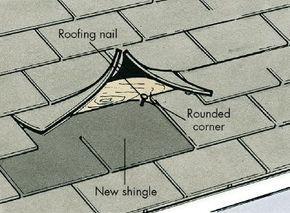Shingle Roofs
Shingle roofs are usually easy to fix. At the marked leak point, look for damaged, curled, or missing shingles. At every place where two surfaces meet and around every chimney or vent, look for breaks in the flashing or caulking or for gaps in the lines of roof cement.
Advertisement
If you can't see any damage to the shingles or flashing in the leak area, you'll have to call a professional roofer; the problem may be inadequate flashing or simply deterioration of the shingles.
If you find evidence of shingle problems, repairs are fairly simple. Curled-back shingles can be reattached with asphalt roof cement or compound in tubes for use with a caulking gun. In warm weather, you can easily straighten out the curled shingle. In cold weather, shingles become very brittle and must be softened before they can be flattened out.
To soften a brittle shingle, carefully use a propane torch with a flame-spreader nozzle. Apply the flame carefully to the curled edges of the shingle; it should get just warm enough to soften but not hot enough to catch fire. Then flatten the edges of the shingle.
To reattach the shingle, apply roof cement generously to the bottom; a good dollop of cement at each corner is usually enough.
Press the shingle firmly into place.
If shingles are torn, rotten, or missing, they should be replaced with new ones. Any shingle that lifts right off the roof with no effort is rotten and should be replaced.
If you find a large area of rotten shingles, you may need a whole new roof. If so, consider calling a professional roofer. Otherwise, replace the damaged shingles with shingles left over
from the previous roof installation.
If you can't get matching shingles, you can
make do with nonmatching ones. In an emergency, cut shingle-size patches from sheet aluminum or copper.
To replace damaged shingles:
Step 1: To remove damaged shingle, lift edges of surrounding shingles, and carefully remove nails with pry bar. Slide out old shingle. If there's loose or brittle roof cement left under it, scrape opening clean. When shingles are blown off by a storm, remove any protruding nails left in roof. Nails that don't stick up can be left in place.
Step 2: To make it easier to slide new shingle into place, slightly round its back corners with sharp utility knife.
Step 3: Slide new shingle into gap, with its front edge aligned with shingles on each side and its back edge under shingles in row above it.
Step 4: Lift corners of overlapping shingles and fasten top of new shingle with 6d galvanized roofing nails driven through each corner. Cover nail heads with roof cement, then smooth down overlapping shingle edges.
If you're replacing rows of shingles, you only need to round the back corners where the top row meets the row above. Ridge shingles, the tent-shape shingles along the peak of a roof, can be replaced the same way. Overlap them along the ridge and over the shingles on both sides. Do not try to use flat shingles; you must use new ridge shingles. Cover the back of each new ridge shingle with roof cement before setting it into place. Secure each corner of the shingle with a roofing nail, and cover the nail heads with roof cement.
After replacing the damaged shingles or if the shingles are undamaged, inspect the chimney flashing, the flashing around vents or vent pipes, and any line of roof cement where two surfaces meet.
If the metal flashing around a chimney or dormer is not thoroughly caulked, fill the joints with roof cement in a caulking gun. Along joints sealed with a line of roof cement, apply roof cement with a putty knife to areas that look worn or cracked. Apply the cement liberally, covering the questionable areas completely. If there are any exposed nail heads in the flashing, cover them with roof cement.
Flat roofs and shake roofs have their own set of unique leak problems -- and unique ways of conquering these issues. Read the next section for helpful tips about repairing leaks on these types of roofs.
